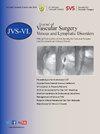门诊支架置入术的时机与非血栓性髂静脉病变的支架大小有关。
IF 2.8
2区 医学
Q2 PERIPHERAL VASCULAR DISEASE
Journal of vascular surgery. Venous and lymphatic disorders
Pub Date : 2025-08-23
DOI:10.1016/j.jvsv.2025.102303
引用次数: 0
摘要
目的:支架置入术是治疗非血栓性髂静脉病变的常用方法。在手术当天,患者通常在午夜后禁食,可能经常出现体积不足和不同程度的脱水。这项研究的目的是确定一天中进行静脉造影的时间是否可以预测用于治疗非血栓性髂静脉病变的髂静脉支架的大小。方法:回顾性研究2013年1月至2022年3月在同一机构接受门诊静脉造影并首次治疗非血栓性髂静脉病变的患者。暴露变量是门诊静脉造影进行的时间,作为禁食时间的代理。静脉造影时间分为“早队列”(上午11点前)和“晚队列”(上午11点后)。小支架尺寸定义为12-16毫米(mm),大支架尺寸定义为18-22毫米。多变量logistic回归分析评估了静脉造影时间与髂静脉支架大小之间的独立关联。结果:64例患者符合纳入标准,其中53% (n=34)属于晚期队列。研究人群的中位年龄为53岁(IQR, 39-64岁)。患者中75%为女性,30%为非白人,69%为非西班牙裔。尽管在早期和晚期队列中,支架植入前的基线特征或髂静脉血管内超声测量值没有显著差异,但与晚期队列相比,早期队列中的患者更有可能使用大支架尺寸(70%对44%,p=0.037)。在多变量logistic回归中,静脉造影时间每晚1小时,使用较小静脉支架的几率增加28% (p = 0.036)。年龄较大也独立预测了较小支架的植入(OR, 0.95; 95% CI, 0.91-0.99; p = 0.022)。结论:当天晚些时候进行门诊静脉造影与接受非血栓性髂静脉病变治疗的患者支架尺寸较小相关。手术时间的9小时差异与支架尺寸减小2mm相关(即支架尺寸减小1个)。未来的研究应探讨术前水化方案在优化髂静脉病变患者支架尺寸中的作用。本文章由计算机程序翻译,如有差异,请以英文原文为准。
Timing of outpatient stenting is associated with stent size in nonthrombotic iliac vein lesions
Objective
Stent placement is commonly used to treat nonthrombotic iliac vein lesions (NIVLs). On the day of surgery, patients typically fast after midnight and may often present with volume deficits and various degrees of dehydration. This study aims to determine if the time of day stenting is performed predicts the size of the iliac vein stent used to treat NIVLs.
Methods
A retrospective study of patients who underwent outpatient stenting and first-time treatment for NIVLs at a single institution from January 2013 to March 2022 was performed. The exposure variable was the time of day the outpatient stenting was performed, serving as a proxy for fasting duration. Stent timing was dichotomized into an early cohort (procedures before 11 am) and a late cohort (procedures after 11 am). Small stent size was defined as 12 to 16 mm, and large stent size was defined as 18 to 22 mm. A multivariable logistic regression analysis evaluated the independent association between the timing of stenting and iliac vein stent size.
Results
Sixty-four patients met the inclusion criteria, with 53% (n = 34) in the late cohort. The median age of the study population was 53 years (interquartile range, 39-64 years). Patients were 75% female, 30% non-White, and 69% non-Hispanic. Although there were no significant differences in baseline characteristics or iliac vein measurements on intravascular ultrasound examination before stenting between the early and late cohorts, patients in the early cohort were significantly more likely to have a large stent size used compared with the late cohort (70% vs 44%; P = .037). On multivariable logistic regression, each additional hour later in the day that stenting was performed was associated with a 28% higher odds of using a smaller venous stent (P = .036). Older age also independently predicted the implantation of a smaller stent (odds ratio, 0.95; 95% confidence interval, 0.91-0.99; P = .022).
Conclusions
Outpatient stenting performed later in the day was associated with a smaller stent size in patients treated for NIVLs. A 9-hour delay in stent placement was associated with a 2-mm reduction in stent diameter (ie, one stent size smaller). Future studies should investigate the role of a preoperative hydration protocol in optimizing stent sizing for patients with iliac vein lesions.
求助全文
通过发布文献求助,成功后即可免费获取论文全文。
去求助
来源期刊

Journal of vascular surgery. Venous and lymphatic disorders
SURGERYPERIPHERAL VASCULAR DISEASE&n-PERIPHERAL VASCULAR DISEASE
CiteScore
6.30
自引率
18.80%
发文量
328
审稿时长
71 days
期刊介绍:
Journal of Vascular Surgery: Venous and Lymphatic Disorders is one of a series of specialist journals launched by the Journal of Vascular Surgery. It aims to be the premier international Journal of medical, endovascular and surgical management of venous and lymphatic disorders. It publishes high quality clinical, research, case reports, techniques, and practice manuscripts related to all aspects of venous and lymphatic disorders, including malformations and wound care, with an emphasis on the practicing clinician. The journal seeks to provide novel and timely information to vascular surgeons, interventionalists, phlebologists, wound care specialists, and allied health professionals who treat patients presenting with vascular and lymphatic disorders. As the official publication of The Society for Vascular Surgery and the American Venous Forum, the Journal will publish, after peer review, selected papers presented at the annual meeting of these organizations and affiliated vascular societies, as well as original articles from members and non-members.
 求助内容:
求助内容: 应助结果提醒方式:
应助结果提醒方式:


